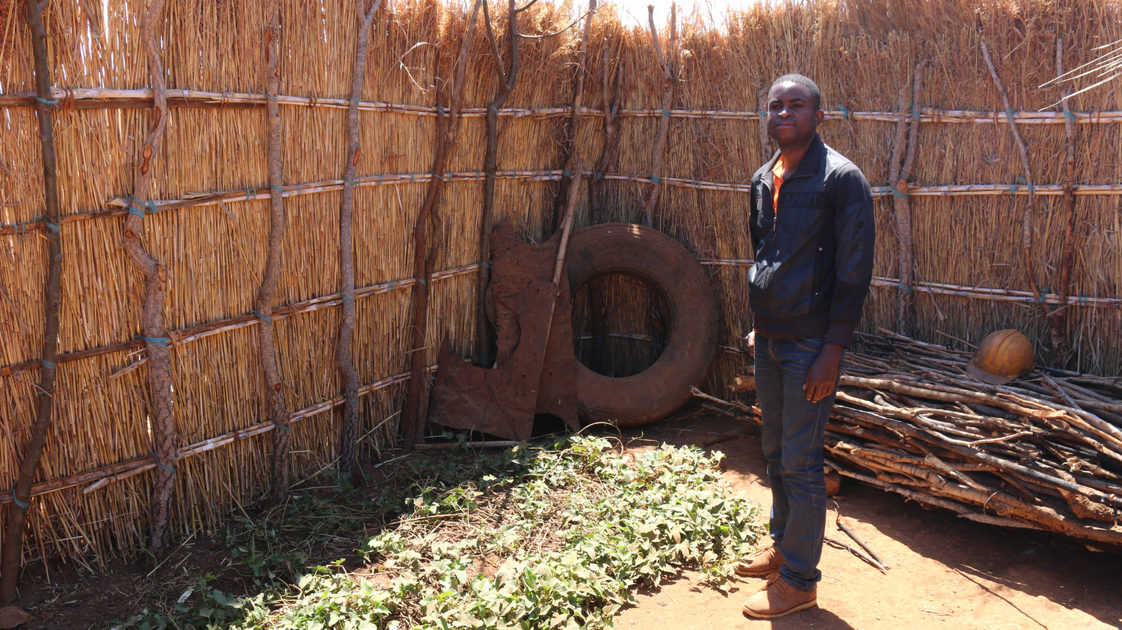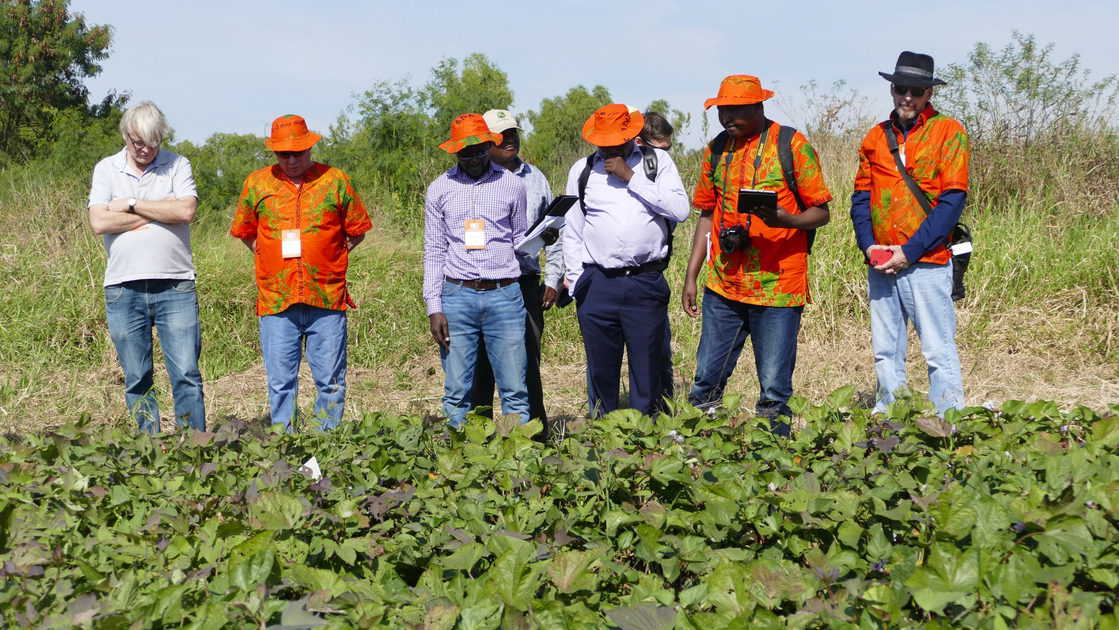
| CRP CGIAR Research Program on Roots, Tubers and Bananas (RTB) |
CRP Partner International Potato Center (CIP) |
Geographic scope Uganda, Kenya, Tanzania, Ethiopia, Rwanda, Burundi, Mozambique, Malawi, Zambia, Madagascar, Angola, South Africa, Ghana, Nigeria, Burkina Faso, Côte d’Ivoire |
Donors Bill & Melinda Gates Foundation (BMGF) Department for International Development United Kingdom (DFID) United States Agency for International Development (USAID) Irish Aid Alliance for a Green Revolution in Africa (AGRA) |
| Partners CGIAR Research Program on Agriculture for Nutrition and Health (A4NH) Catholic Relief Service (CRS) Forum for Agricultural Research in Africa (FARA) Program for Appropriate Technology in Health (PATH) North Carolina State University (NCSU) Helen Keller International (HKI) Farm Concern International (FCI) HarvestPlus Farm Africa University of Greenwich World Vision Australia Euro-Ingredients Ltd |
Contact people Jan Low, CIP Robert Mwanga, CIP Maria Andrade, CIP |
Website Sweetpotato Knowledge Portal |
Social media YouTube |
In sub-Saharan Africa, around 48% of children under five suffer from vitamin A deficiency, which can lead to weakened immune systems, increased risk of blindness, diarrhea, and other health problems. While all types of sweetpotato are good sources of minerals and vitamins, only orange-fleshed sweetpotato (OFSP) has large amounts of the antioxidant beta-carotene, which the body converts into vitamin A. The deeper the color, the more beta-carotene, and just one small root (120 grams) of a medium-intensity OFSP variety is enough to meet a child’s daily vitamin A needs.
Since 2009, the Sweetpotato for Profit and Health Initiative (SPHI) has contributed to fighting malnutrition in children. SPHI is led by the sweetpotato program of the International Potato Center (CIP) and the Forum for Agricultural Research in Africa (FARA) and is part of the CGIAR Research Program on Roots, Tubers and Bananas (RTB). The initiative has contributed to the release of 162 improved varieties of sweetpotato bred in Africa, including 104 OFSP varieties, across 16 countries in sub-Saharan Africa, and promoted their broader use. From 2010 to 2019, more than 29 million individuals (in more than 6.2 million households) have been reached directly or indirectly with improved varieties of sweetpotato.
An important aspect of SPHI has been the integration of breeding programs, extension-style agronomy and nutrition education for farmers and consumers, and the implementation of effective marketing and dissemination strategies. This multi-dimensional approach has ensured that OFSP has been incorporated into the diets of rural families, resulting in significantly reduced levels of micronutrient deficiencies, hidden hunger, and disease. New market opportunities for processed products using OFSP as a key ingredient, especially in baked products, have also been identified and piloted.
The impact of RTB’s OFSP work on reaching CGIAR’s System-level Outcomes (SLOs) and the United Nations Sustainable Development Goals (SDGs) are summarized below.
Key impacts
2019 SLO target 2.3: 150 million more people, of which 50% are women, without deficiencies of one or more of the following essential micronutrients: iron, zinc, iodine, vitamin A, folate, and vitamin B12
|
Recognized benefits of sweetpotato
In sub-Saharan Africa, sweetpotato is a relatively easy crop to grow. It is the third most important food crop in terms of production in East Africa, and the fifth most important food crop in Southern Africa. It is a primary staple in Rwanda, Burundi, Uganda and Malawi (where more than 80 kilograms per capita are consumed each year).
Considered a food security crop, sweetpotato is drought-tolerant once established, and available at times when maize fails. On average, it has a higher daily energy output per hectare than maize. For the past 20 years, the area under sweetpotato has been expanding faster than all other staple food crops in sub-Saharan Africa.
The contribution of RTB work on agriculture and nutrition with respect to OFSP has been widely recognized and the CGIAR Research Program on Agriculture for Nutrition and Health (A4NH) has also played an important role in promoting its use. In 2016, three CIP scientists, Maria Andrade, Jan Low, Robert Mwanga, and Howarth Bouis of HarvestPlus (part of A4NH), received the World Food Prize for their work on biofortification. In the same year, CIP received the Al-Sumait Food Security award for its work on OFSP.
Between 2010 and 2019, over 29 million individuals (more than 6.2 million households) have been reached directly or indirectly with improved varieties of sweetpotato.
A developing research agenda
In 1995, recognizing its potential to address widespread vitamin A deficiency in sub-Saharan Africa, RTB, CIP, and the Kenyan Agriculture Research Institute (KARI) began research on OFSP. The nutrition community needed convincing that biofortification could work. Initially, efficacy and effectiveness studies focused on determining the impact of OFSP consumption on vitamin A intake and status. Early breeding programs were not always based in Africa, but over time it became apparent that it was essential to breed improved varieties in Africa to combine the beta-carotene trait with the agronomic and taste characteristics required for adoption.
In 2009, the Bill & Melinda Gates Foundation funded CIP to lead the five-year Sweetpotato Action for Security and Health in Africa (SASHA) project. The grant supported the establishment of advanced breeding programs in three sub-regions to address virus resistance (Uganda), drought tolerance (Mozambique), low sugar (Ghana), seed system research, and further research on delivery models, including establishing a value chain for developing a commercial OFSP-based processed product in Rwanda, the Golden Power Biscuit. It also funded the testing of the “Mama SASHA” model, whereby pregnant women attending ante-natal care clinics received improved nutrition counseling and vouchers to redeem OFSP planting material. Reduced stunting and vitamin A deficiency was evidenced in children under two years old when their mothers fully participated in the intervention. In addition, the Alliance for a Green Revolution in Africa (AGRA) concurrently supported nine national sweetpotato breeding programs. The SASHA project was renewed for a second five-year phase in 2014.
Knowing that diffusing technologies is critical for impact, and requires strong partnerships, the Sweetpotato for Profit and Health Initiative (SPHI) was launched as a partnership mechanism by CIP alongside the SASHA effort in late 2009. This multi-sector, multi-donor, multi-partner effort aimed to:
- Build consumers’ and producers’ awareness of sweetpotato’s nutritional benefits;
- Ensure that African households in 16 target countries received access to improved varieties of sweetpotato;
- Diversify the use of sweetpotato on the continent; and
- Expand market opportunities for sweetpotato growers.
While the SPHI worked on all types of sweetpotato, biofortified OFSP encapsulates the philosophy that good health is essential for generating wealth and efforts to reduce poverty and malnutrition.

Breeding and technologies
The successful breeding effort was underpinned by the deployment of CIP’s accelerated breeding scheme, which reduced the breeding cycle period from 8-10 years to 4-5 years. Under the SPHI umbrella and with the involvement of CIP’s breeding team, many varieties bred in Africa were broadly adapted and shared between countries for use in their selection programs. Thus, in total, 162 varieties were released in 16 countries, of which 104 were orange-fleshed (Figure 1). These varieties were distributed as part of development programs focused on reducing malnutrition and poverty among smallholder farmers, and in response to natural disasters, such as droughts or floods. Figure 1 presents the sweetpotato varieties distributed throughout sub-Saharan Africa, noting how many were orange-fleshed versus non-orange-fleshed.
Figure 1. Number of sweetpotato varieties released in African countries by flesh color type from 2009-2013 and 2014-2019

One of the greatest challenges related to a crop propagated on vines like sweetpotato is the perishability of the seed and the accumulation of insect-transmitted virus diseases in the vines, which leads to lower yields. CIP’s seed team and partners developed two important technologies to improve seed quality and availability. Research in Uganda demonstrated that the Triple S method, which involves the storage of small roots in sand over the dry season, and sprouting them in protected seed beds, is an effective way to have seed ready to go in areas with dry seasons lasting more than four months.
This technique has subsequently been improved and validated in Ethiopia and Ghana, where an RTB scaling project is testing different approaches to taking the technology to scale. On average, one sprouted root generates 40 plant cuttings that are ready for when rain comes. In contrast, low-cost net tunnels and mini-screenhouses were developed and tested with seed multipliers in nine countries. Most suitable for areas with two rainy seasons annually, the netting helps reduce exposure of the planting material to aphids and whiteflies, which transmit viruses. This helps to maintain a stock of high quality, disease-free planting material to be further multiplied in the field.
Beyond new varieties, the social and nutrition sciences team of CIP and partners have promoted diversified uses of sweetpotato through improved complementary foods for young children that include OFSP as a key ingredient; the use of OFSP purée for baked products; and other value-added products such as juices, fries and crisps. Research in Rwanda and Kenya has demonstrated that OFSP purée can be an economically viable, vitamin A-enhancing ingredient in commercial baked products.

Scaling up sweetpotato production and consumption – partnerships and capacity development
As sweetpotato is propagated using vine cuttings, to distribute new varieties, CIP and its partners established 1,030 decentralized vine multipliers – farmers who could produce and sell vines to neighboring villagers – in 11 SPHI target countries. SPHI established a monitoring system with its partners to annually track farmers who had received vines of new sweetpotato varieties and how many people had been reached.
To assist government extension programs and non-governmental partners to train their staff, a range of capacity development initiatives were developed. A ten-day training course was designed based on a set of 13 training-of-trainer modules in five languages. Local training institutions implemented the courses with RTB support in Mozambique, Tanzania, Nigeria, Burkina Faso, Ghana and Ethiopia from 2012 to 2019.
These manuals and other training and investment guides were made available on the Sweetpotato Knowledge Portal to encourage broader use.
An enabling policy environment was also crucial to scaling up the production and use of sweetpotato. HarvestPlus, Helen Keller International and CIP collaborated closely to identify and train advocates within key countries and at the regional level to promote biofortification, with OFSP being the first biofortified crop available in many African countries. Between 2011 and 2019, the terms “biofortification”, “orange-fleshed sweetpotato”, and “nutritious foods” appeared in seven regional policy documents, 23 national agricultural policy documents, and 18 national nutrition documents, facilitating greater uptake and use.
Selected peer-reviewed articles
Patterns and structure of household income inequality in rural Ethiopia (2019)
Efficiency of insect‐proof net tunnels in reducing virus‐related seed degeneration in sweetpotato (2019)
Gene pool subdivision of East African sweetpotato parental material (2018)
From lab to life: Making storable orange-fleshed sweetpotato purée a commercial reality (2018)
Effect of sources of sweetpotato planting material for quality vine and root yield (2017)
Tackling vitamin A deficiency with biofortified sweetpotato in sub-Saharan Africa (2017)
Further resources
Dataset: Sweetpotato (CIP-related) varieties released in 2019 in Africa
Conference paper: The effect of nutrition knowledge on consumption of orange-fleshed sweet potato bread in Nairobi, Kenya (2019)
Conference paper: Does nutrition education influence retention of vitamin A bio-fortified orange-fleshed sweet potato in farms? Evidence from Kenya (2019)
Header photo: Children eating orange-fleshed sweetpotato. Photo by I. Corthier/CIP.





